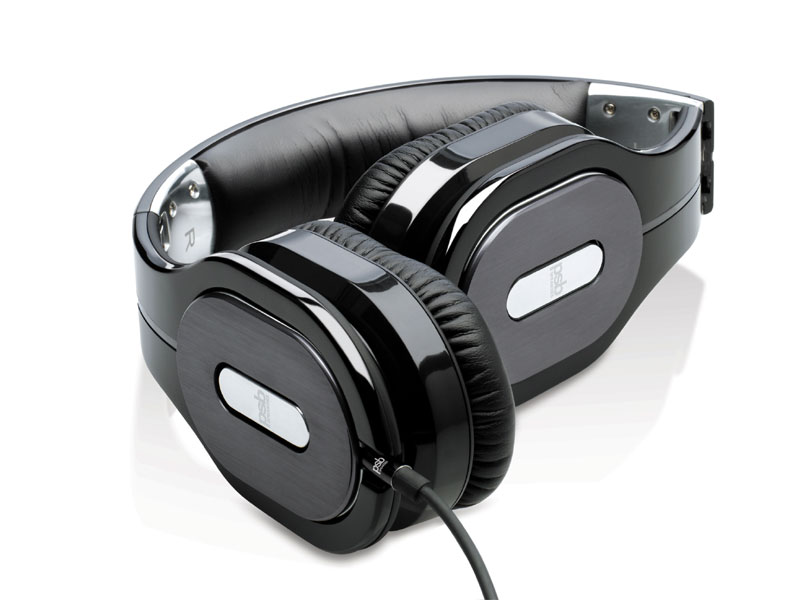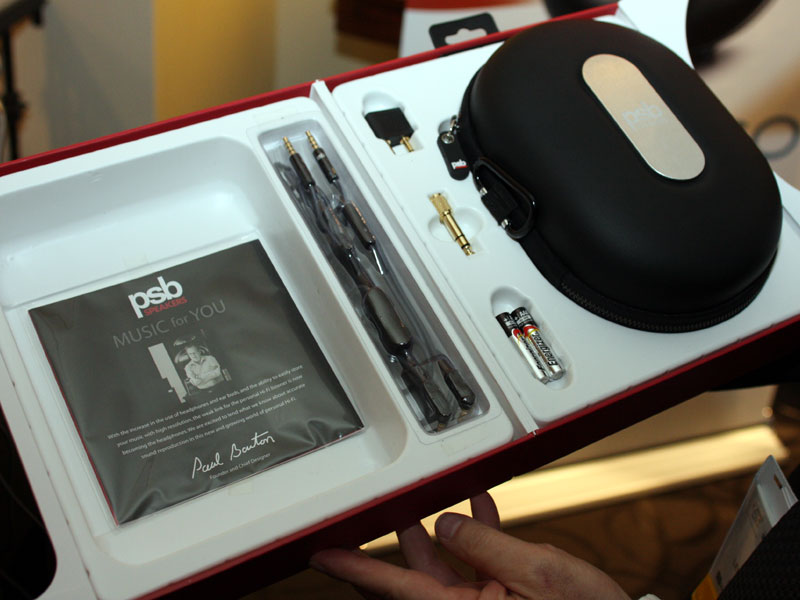To Munich and Back With the PSB M4U 2 Headphones
t CES earlier this year, Paul Barton showed off his new active noise-canceling M4U 2 headphones ($400). After spending only a few minutes with them connected to my iPhone, it was obvious to me that Paul had created the best noise-canceling headphones on the market. I’ve owned various Bose models for many years and many tens of thousands of flight miles. I’ve tried other contenders as well, but I found none quite good enough to justify the cost of another set of expensive travel headphones. At least that is where things stood until I heard the M4U 2s in Las Vegas. I immediately began to think of how much more bearable the very long flight to Munich in late May for the High End Show would be with a pair of these beauties. They were supposed to be available in February, but then February turned into March, which turned into early April, and still the PSBs had not arrived. Then two weeks before my flight, the manufacturing delays turned around and the box arrived, with time to spare for burning in the headphones for a few days.
Except for the geeky name (M4U stands for "Music For You"), Paul Barton was on a roll, incorporating truly original and useful ideas into these ‘phones. First, there are three options for use. The 'phones incorporate an amplifier and a noise-canceling circuit, both of which require power from a pair of AAA batteries. You also have the option of listening to the headphones with neither the amplifier nor noise canceling, so if your batteries run out, you still have operational headphones. This option provides much, much more than just letting you use the headphones without power, however. No matter how good the headphones, with noise cancellation engaged, the sound quality will suffer. With something like Bose’s two models, this hardly matters because there is no pretension of high-quality sound. Bose’s noise-reduction circuitry, along with packaging and marketing, carried the company to market dominance without the need to satisfy audiophiles. The M4U 2s are a whole other kettle of fish.
But first let’s get back to PSB’s packaging and design. The packaging brings to mind Steve Jobs' obsessive attention to detail. Like an iPhone box, the box for the M4U 2 is a little jewel of design and quality. The headphones come in an oval hard clamshell package that unzips and folds open to display the ‘phones folded up into thirds on one side, and a package of goodies held in by netting on the other. Included are an extra set of leatherette ear cushions, two cord options, a lanyard for hooking the case to a belt or suitcase for transport, a cleaning cloth, an airline pin adapter and a 1/8"-to-1/4" adapter. The very flexible cords each have a kill button to turn off the sound if you want to hear outside conversation. One of the cords adds remote control and a microphone for using the headphones with a cell phone. The cord can be inserted into either the left or right earpiece. The right earpiece includes a three-position switch -- the off position allows use of the headphones without power, the on position adds amplification, and the "anc" position adds noise reduction with amplification. This means that the M4U 2s can be three different headphones in one. But first and foremost, this is an audiophile-quality noise-reduction ‘phone for air travel. Second, in passive mode, the M4U 2 can perform as portable headphones to couple with your iPhone and portable amplifier (and portable DAC if desired). And with the included amplifier switched on, you can leave the portable amplifier at home and travel next to naked -- with just your source and the headphones. I’ve always kept a pair of headphones about the house and have tried everything from Stax electrostats to in-ear monitors (IEMs). My home system includes Grado RS-1s driven by a Ray Samuels Emmeline HR-2, a rather dated and modest system by headphone-fanatic standards. I’ve been tempted on occasion to add the fabulous Audez'e LCD-3 headphones to my system, and find myself browsing Head-Fi.org, even showing up on occasion for their meets. But at home I have no neighbors to worry about, and no matter how good the portable rig, music from a good set of speakers is the way I like to listen. So headphone use for me means portable audio. Shutting out the sound of jet engines while traveling until now has meant an extreme case of sonic compromise. I’ve tried to get around the poor sound of noise-canceling headphones with the use of high-quality in-ear monitors that block airplane sound without the distortion of a noise-canceling signal. IEMs are great for cutting out airplane noise, and with the best drivers they offer truly excellent sound. But I can’t bear to have plugs in my ears for more than about an hour without feeling like a character from the movie Alien. Hence my expensive ear molds sit unused in a gadget bag. Enter the PSBs. Flying from San Francisco to Munich means sitting on an airplane for at least 12 hours in each direction, so I downloaded a few books to my iPad and packed a Trent power pack, a couple sets of batteries, the portable Emmeline Mustang P-51 and an ALO Cryo Triple-Pipe line-out dock connector. My only mistake was looking in the mirror at home with the PSBs atop my head. These are substantial headphones and immediately set you apart from the Bose crowd. Okay, I’ll look a bit geeky, but I’ve weathered years of non-audiophile houseguests who think I’m deranged. So I had 24 hours of travel time standing out from the crowd of Boseheads as well as the occasional spot of downtime in between flights to listen to the three variations the PSB 'phones present. It took only a fraction of that time to conclude that these may be my all-time favorite headphones -- not the best-sounding, but as a fun product combining great-sounding ‘phones in an extremely user-friendly package. In fact, it's hard to think of any headphones that have given me more pleasure. Let’s start with the sound of the PSBs without battery power, the purest way. Without power from either the 'phones themselves or an external amp, the iPhone’s internal amplifier can drive the M4U 2s on most material, although you will need to have the volume slider pushed up near the top of its range and the sound quality will be limited by the less-than-stellar amplifier in the iPhone. Given the option of the internal amplifier, however, the real beauty of this purist setting is the option to use the headphones with an external amplifier. With this configuration, the 'phones are really not that far from some of the best available. Sure, you can get better sound with several top-shelf 'phones, such as models from Audez'e, Grado and Sennheiser, or with something like the JL Audio in-ear monitors with custom-fitted ear molds. But these are much more expensive alternatives. In the case of the headphones I mentioned, they are not portable. In the case of the IEMs, you must stuff a big wad of silicone into your ear canal. The PSBs have an excellent sense of space and dimension missing from all but the best headphones. While they are not the last word in delicacy and air around the instruments, they do a very credible job at a fraction of the usual cost of headphones that shine in this department. They have real bass, not the mush you hear from most portable headphones. Similarly, they have dynamic quickness not usually associated with headphones in this price range and never with noise-canceling ‘phones. What really surprised me, however, was when I compared the M4U 2's internal amplifier with my Emmeline, which costs almost as much as the headphones themselves. As much as I like good sound, I’m no fan of the fuss involved in external amps. First, including the iPhone, the package becomes a little large to slip into your pocket. Second, and more bothersome, is the need to strap the units together, lest the cable interface slips out of place. But could I really do without the external amp? The amp included with the M4U 2s is better than I expected. It's not quite as good as a high-quality external amplifier, but the differences between it and my amp were not dramatic. I admit to sliding into using the PSBs with the internal amp and packing up the extra equipment. It’s that good. With noise canceling engaged, as you would expect, there is a fall off in audio quality, but with the PSBs, the effect is less than you might think. How does the noise cancellation stack up to the king of the hill in this department, Bose? I found the M4U 2s and my Bose 'phones to be very similar in this respect. No headphones are going to make airplane noise disappear, but the PSBs perform quite nicely in this department. At home I tested the two headphones by putting my head up against noisy object and compared the sound. While I don’t have anything around the house quite as noisy as a jet engine, I found the noise reduction very much in the same league. Just as important, I found the PSBs to be very comfortable; I never reached a level of fatigue requiring me to take a break. I would have more to say, but I have to pack up my PSBs
and get ready for a five-hour flight in the morning. These cans really take the sting out
of air travel. |


